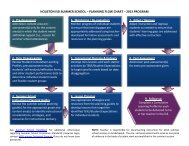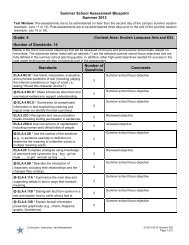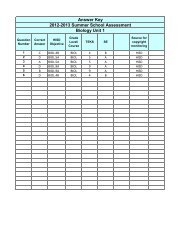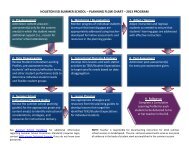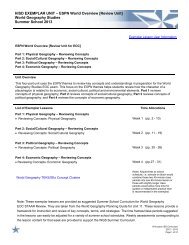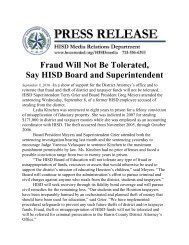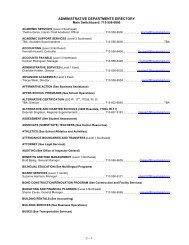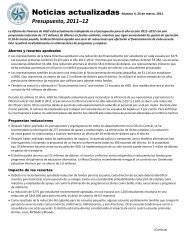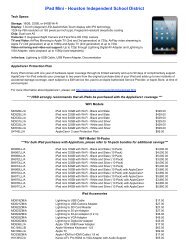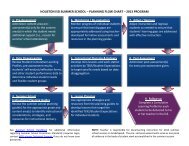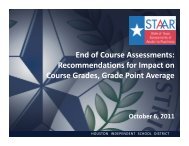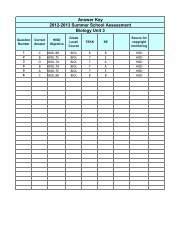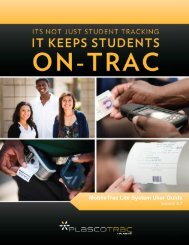SSK Unit 4.2 Planning Guide
SSK Unit 4.2 Planning Guide
SSK Unit 4.2 Planning Guide
- No tags were found...
You also want an ePaper? Increase the reach of your titles
YUMPU automatically turns print PDFs into web optimized ePapers that Google loves.
Instructional ConsiderationsHISD PLANNING GUIDEEnglish Language Arts Grade 7SUMMER SCHOOLExplain the importance of textual evidence to support thesis statements. Emphasize that informational texts conveyinformation about a topic that guide and inform the reader’s understanding of key ideas and evidence. Explain that inaddition to effective thesis statements, they must include specific facts, details, and examples as evidence that supporttheir thesis without adding unnecessary information. Clarify that there are two types of textual evidence, direct quotesand paraphrased statements. Use a Think-Aloud to model the process for incorporating direct quotes and paraphrasedstatements from texts to support a thesis. Emphasize the need to embed quotes using correct punctuation. See UsingQuotations Effectively in Instructional Strategies and Laying the Foundation: A Resource and <strong>Planning</strong> <strong>Guide</strong> for PreAPEnglish Grade Seven in Resources. (ELA.7.14B, ELA.7.17A.ii, ELA.7.17A.iv)Remind students that only proving textual evidence is not sufficient to support a thesis. Students must also provideinsightful commentary to interpret, explain, or illustrate the effect of the textual evidence. Explain that unlike textualevidence, commentary is based solely on the writer’s interpretation.Before drafting, have students complete outlines to verify that the amount of information and evidence present issufficient to support their thesis. See Outline Notes in Instructional Strategies and the WriteSmart DVD-ROM inResources. (ELA.7.14B)Conduct Writing Conferences to monitor student progress. Verify that each student has presented a clear controllingidea, sufficient evidence, and appropriate organizational pattern. See ELA Best Practices MS in Resources.(ELA.7.14B)Remind students to include transitions as they move from sentence to sentence, idea to idea, or paragraph toparagraph. Present students with a list of transition words and strategies to reference. Encourage students to keep thisinformation in their Writer’s Notebooks. See Transition Words and Strategies and Transition Chart in Resources.(ELA.7.14C, ELA.7.17A.v, ELA.7.19A.viii)Review the steps of the revision process. Remind students to review the 6+1 Traits to guide their revision. This lessonset examines transitions and sentence fluency. Use Writing Conferences to determine the students’ level of familiaritywith grammar basics. Provide students with extra review and practice on these elements if necessary. (ELA.7.14C)Remind students that evaluating organization is also a part of the revision process. Good organization includes not onlya strong and effective organizational pattern but also effective thesis statements, varied sentence constructions, andtransitions. (ELA.7.14C, ELA.7.17A.ii, ELA.7.19A.viii, ELA.7.19B, ELA.7.19C)<strong>Guide</strong> students in revising their essays down to twenty-six lines. Model combining sentences as necessary toincrease style quality and reduce space. Explain the necessity of using precise and concise language to conveyideas. Students must practice writing in timed situations in order to understand the process of revising essayseffectively and efficiently. See the official STAAR Composition Box template in Resources.Review independent vs. dependent, or subordinate, clauses. Reiterate that the use of a dependent clause to createcomplex sentences requires the use of a subordinate conjunction while compound sentences use coordinatingconjunctions. Emphasize the need to include a comma at the end of a dependent clause if it is placed at the beginningof a complex sentence. As students revise, emphasize the need to use a variety of sentence structures, includingsimple, compound, and complex sentences. See Grammar Notes DVD-ROM in Resources. (ELA.7.19B, ELA.7.19C,ELA.7.20B.i)To assist students in using appropriate conjunctions that connect compound and complex sentences, see FANBOYSand WABU WABU WATIST in Instructional Strategies and Anderson’s Everyday Editing in Resources. (ELA.7.14C,ELA.7.19B, ELA.7.19C)Use revision stations to address sentence fluency, transitions, and thesis statement revisions. See Revision Stations inInstructional Strategies. (ELA.7.14C, ELA.7.17A.ii, ELA.7.19A.viii) - English Language Proficiency Standards (ELPS) - Literacy Leads the Way Best Practices - Aligned to Upcoming State Readiness Standard- State Process Standard R - State Readiness Standard S - State Supporting Standard© Houston ISD Curriculum2012 – 2013Page 7 of 12




